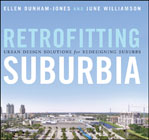
Retrofitting suburbia: urban design solutions for redesigning suburbs
Dunham-Jones, Ellen
While there has been considerable attention by practitioners and academics todevelopment in urban cores and new neighborhoods on the periphery of cities, there has been little attention to the redesign and redevelopment of existing suburbs. Here is a comprehensive guidebook for architects, planners, urban designers, and developers that illustrates how existing suburbs can be redesignedand redeveloped. The authors, both architects and noted experts on the subject, show how development in existing suburbs can absorb new growth and evolve in relation to changed demographic, technological, and economic conditions. INDICE: Preface. Introduction. Urban versus suburban form. Why retrofits? Why now? Organization of the book. Acknowledgements. PART I. THE ARGUMENT. Chapter 1: Instant Cities, Instant Architecture, and Incremental Metropolitanism.Instant cities and suburban retrofits. Instant architecture, instant public space. Incremental metropolitanism. How sustainable? How urban? Portfolio of Suburban Retrofits. PART II. THE EXAMPLES. Chapter 2: Retrofitting Garden Apartments and Residential Subdivisions to address density and the new demographics.Demographic changes. Never homogenous? The new suburban history. The imperative to accommodate diversity. Retrofitting residential subdivisions. Revising the rules: Kansas City First Suburbs Coalition and DADUs in Seattle. Connect the culs-de-sac: Apollo Beach and Laurel Bay. From subdivision to edge city: Greenway Plaza. From subdivision to TOD: MetroWest. Reintegrating garden apartment buffer sites. Accommodating new immigrants: Brookside Apartments and Gulfton. Market devaluation: Park Forest Courts. Gentrification infill: Gramercy and The Colony. Tomorrows suburbanites. Residential retrofitting typology or whereto park the cars. Chapter 3: Residential Case Study: Changes to "Levittown". The earliest postwar suburbs are sixty years old. Chapter 4: From Commercial Strips to Social and Sustainable Infrastructure. Third places in suburbia? History of the strip and its building types. The drive out of town. Adaptive re-use of big boxes and strip malls for community-serving activities. Reviving ghostboxes. From strip malls to community anchors: La Grande Orange and Camino Nuevo. Retrofitting shopping centers - the middle scale. Re-greening: Phalen. Public sector strategies to support retrofitting. Santana Rows rough road to riches. From strip centers to new downtown: Temple Terrace. Retrofitting the corridors themselves. The transit boulevard and the urban network. Return of the multiway boulevard: Cathedral City. Rezoning corridors: three examples in Atlanta. Inducing transit on a corridor through form-based codes: Columbia Pike. Retrofitting the urban structure of commercial strips. Social infrastructure. Chapter 5: Strips Case Study: Mashpee Commons, Cape Cod, Massachusetts. Attachingto a well-established fragment of urbanism. Chapter 6: From Regional Malls, to New Downtowns Through Mixed-Use and Public Space. The significance of publicspace. A brief history of malls. Dead and dying malls. Changing uses to meet local needs. Downsizing: Park Forest and Willingboro. From enclosed malls to new downtowns. From dead mall to new downtown: Mizner Park. Turning a mall inside out: Winter Park Village. Incremental metropolitanism around Denver: Englewood CityCenter. Infilling around a live mall. You can save the tree and have Tiffanys too: Walnut Creek. From mall to transit-served university and office tower: Surrey Central City. The role and form of mixed-use and public space in retrofitted malls. Chapter 7: Mall Case Study: Cottonwood, Holladay, Utah. From concept to press release. Chapter 8: Mall Case Study: Belmar, Lakewood, Colorado. "Enrich your Life, Not your Lawn" in Lakewoods new downtown. Chapter 9: Edge City Infill: Improving Walkability and Interconnectivity. Redirecting Edge Cities. The evolution of edge and edgeless cities. Edgeless cities. Infilling edge cities. Addison Circle. Legacy Town Center. Perimeter Center. How effective are the infill strategies?. Edge city retrofits across multiple parcels. The future of edge cities. Chapter 10: Edge City Case Study: Downtown Kendall/Dadeland, Miami-Dade County, Florida. Zoning the creation of new blocks and squares over multiple parcels. Chapter 11: Office and Industrial Park Retrofits to Recruit the Creative Class. Suburban industrial parks, office parks, and corporate campuses. Non-concentric patterns of commuting. Polycentric Atlanta: Bellsouth in Lenox Park, Midtown and Lindbergh City Center. Recruiting the creative class. Retrofitting suburban workplaces. Glass box lofts: Cloud 9 Sky Flats. Lofts on the Interstate: Upper Rock. Retrofitting industrial parks. Instant Urbanism: Westwood Station. Chapter 12: Office Park Case Study: University Town Center, Prince Georges County, Maryland. Finishing a job started almost half a century ago. Epilogue: The Landscape of Incremental Metropolitanism in 2050. Endnotes. Index.
- ISBN: 978-0-470-04123-9
- Editorial: John Wiley & Sons
- Encuadernacion: Cartoné
- Páginas: 272
- Fecha Publicación: 16/01/2009
- Nº Volúmenes: 1
- Idioma: Inglés
